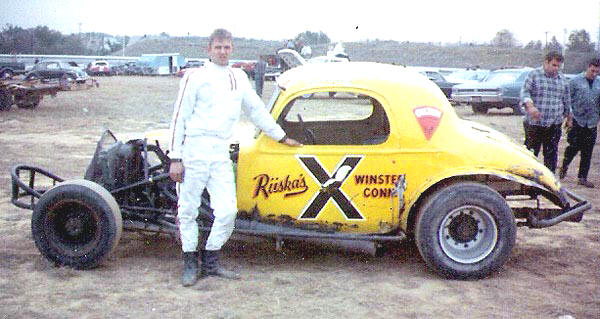
When most people think of the Yellow X, they tend to think of Butch Jelley, too. [Courtesy of Arnie Ainsworth]
THE
BILL'S BACK IN TIME COLUMN PAGE
Copies of my column in Mark Thomas' "Racin'
Paper"
BILL’S BACK IN TIME
By Bill Ladabouche
Site Column #77 from My
Column 93
MORE PHOTOS THAT TELL STORIES
Just about anyone who spends much time looking at vintage eastern modifieds has come across a photo of the Riiska yellow X. Usually, the driver [if one is shown in the photo] is Butch Jelley, then from Pownal, Vermont. Jelley drove the car for a bigger slice of the Riiska team’s life span than anyone else.
Most vintage racing students and devotees also know that Doug Garrison, the legend from Poughkeepsie, NY, was the X’s driver before Jelley. The earlier photos almost always are taken at Lebanon Valley, and they show Garrison at the wheel. My first contact with the car was at the special show at the Vermont State Fair put on by Lebanon Valley in 1960, and Garrison was the driver.

When most people think of
the Yellow X, they tend to think of Butch Jelley, too. [Courtesy of Arnie Ainsworth]
The yellow X team of Martin Riiska came out of Winsted, Connecticut in the 1950’s. Very few people – outside of those who were around at the time, know that Riika’s first driver was not Doug Garrison. It was, most likely, a man named Len Ransom. A photo recently found shows Ransom as the driver of a clearly – early version of the car.
The graphics are exactly the same as those on the cars driven by Garrison and Jelley. The car, with the familiar skunk inside the X, appears to be sitting in a lineup at Stafford; but. It also could be Riverside. My friend, historian Cho Lee acquired this photo from a collection given to him by someone in Southern New England.
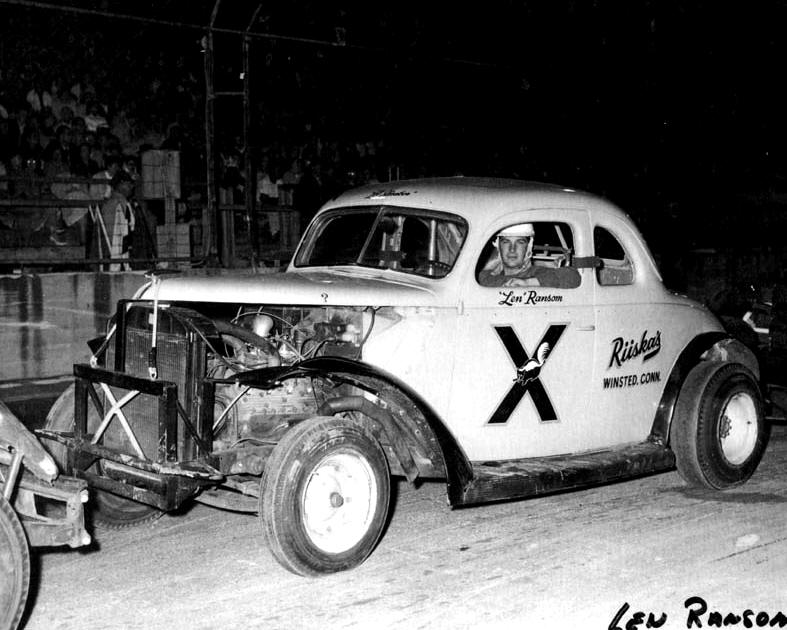
This photo of a Riiska
car recently surfaced. Different driver.
[Courtesy of Cho Lee]
I have never been able to find out much about Martin Riiska, but just looking a all those Yellow X photos tell you a lot about the man. The cars were totally dependable, attractive, and the drivers seemed to stick with them for long periods of time. The X’s seemed to disappear when Jelley went to other cars. I don’t know why, and I haven’t asked Butch. The point is that the Riiska Yellow X was one of the most significant teams in the history of eastern modified and sportsman racing.
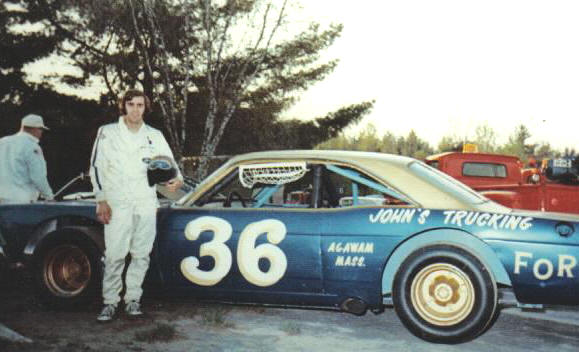
Little John with the blue
and gold car – the most recognizable version. [Courtesy of Andy Boright]
Shaney Loenzent sent me a photo of John Rosati, with one of his Ford late model sportsman cars he ran on the Northern NASCAR circuit. The picture is more interesting than most for a number of reasons. Firstly, few, if any, other Ford late models in that time period were made from the 1967 Ford Fairlane. Rosati had at least two made by the legendary car builder Fred Rosner for his three year NASCAR adventure.
Secondly, this was the least common graphics on the car – something that an old sign painter who specialized in race cars would pay attention to. By the numbers on the car, it had to be the last months he ran up north. The first year, when Team Rosati made it splashy debut in Vermont, the car was blue with a flat black roof. The numbers were white with red. The second year [and some of the third] saw a blue car with a gold roof, and thicker numbers. This last version had the mirrored contact paper numerals.
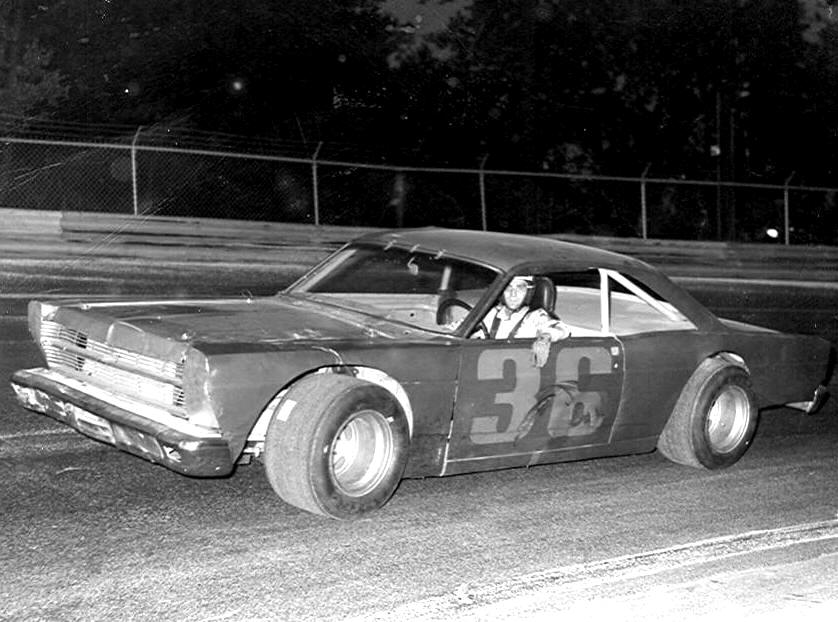
Rosati, at Riverside,
with the final version. [Courtesy of Shaney Lorenzent]
When done running in Vermont, Rosati sold one of the cars to Robert E. “Bucky” Dragon, a controversial logger from Ripton, VT who made occasional appearances in stock cars. Dragon ran the car on dirt at Devil’s Bowl Speedway, and drove it very aggressively – pounding and banging on the rest of the field. The car was not made for dirt racing and was not constructed to be a bulldozer. I don’t know how long it lasted. Be that as it may, the Rosati era [lengthened by John’s popular younger brother, Tom] was one of the most important in the Northern NASCAR era.
The next shot is one of Dover, New Hampshire’s unparalleled Ernie Gahan, a national champion. Ernie seemed to have a number of rides, but the two most frequent were his own #50 and the Sonny Koszella #15’s. Although I have trouble visualizing anyone headquartered out of Rhode Island as being in the lumber business, all of the early Koszella cars bore some reference to that business: an early shot I have shows the car as “The Lumberjack Special”; another version of Gahan’s #15 is called “The Log Roller Special”; and a third variation bears the label “The Wood Chopper Special”.
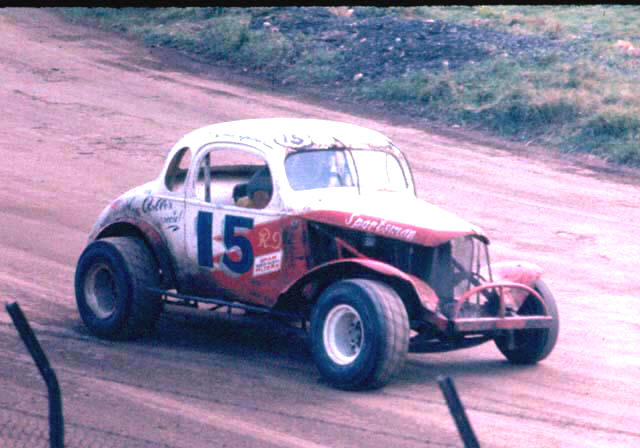
This shot of Ernie, taken
in 1963 probably at Stafford, was in the Log Roller Special. [HAMB Message Board
Site Photo]
As a kid, I began to notice this when the cars would come in to Fonda, and I would stand at the gate, just off NY Route 30A, and snap the cars when they had to slow down to get through the gate. Sometimes, Mr. Gage would stand out there, probably doing an informal car count. I got to know him on an informal basis. Seeing as I really like Ernie, and the Koszella [I hope that’s spelled right] cars went on for years after Ernie, I thought this photo would be fun to put in the article.
My last photo is dripping with possibilities. The shot was taken by Bob Mackey, who I may call a legendary photographer because of all the racing venues he covered and from the insight that he showed in his choice of shots. In this particular picture, we see Bud Besor, apparently not all that pleased, out of his car, the 50NY and headed for a showdown with whomever he felt offended by.
Hold on, here comes Bud !
[Bob Mackey Photo Courtesy of John Rock]
The Airborne Speedway official appears to not be taking the incident as seriously as Besor. From what I have heard about Bud, it may be a good think Besor is not seeing the broad smile on the official’s face. Given the way things at Airborne could get, often, it is entirely possible the official was actually looking forward to Besor reaching his target.
As time went on, Bud Besor dropped out of driving at Airborne. The 50VT, which was connected with Dick Nephew somehow, was dismembered and sold to Tupper Lake’s Gaston Desmarais. Desmarais also bought a wrecked Dick Nephew #6 and made a race car from the two cars. He numbered the car 6 – 50 and used that number for years to come until he finally shortened it to #50. We can only imagine who Bud B was after, but one thing is sure: it wasn’t me and I am damned glad of it.
Return
to the Main Page
Return to the Main News Page
Return to the Columns Link Page
Return to the All Links Page